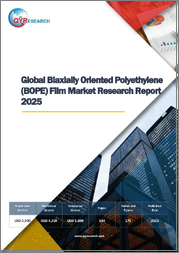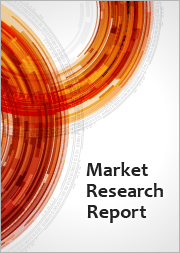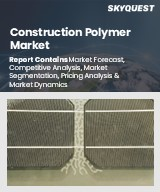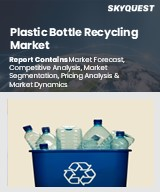
|
시장보고서
상품코드
1481861
세계의 바이오 기반 폴리에틸렌 시장 조사 보고서 : 산업 분석, 규모, 점유율, 성장, 동향, 예측(2024-2032년)Global Bio-based Polyethylene Market Research Report - Industry Analysis, Size, Share, Growth, Trends and Forecast 2024 to 2032 |
||||||
바이오 기반 폴리에틸렌 시장의 세계 수요는 2023년 14억 9,000만 달러에서 2032년 77억 2,000만 달러에 가까운 시장 규모에 도달할 것으로 추정되며, 2024-2032년 조사 기간 동안 20.05%의 CAGR을 기록할 것으로 예상됩니다.
바이오 기반 폴리에틸렌은 화석 연료에서 추출한 기존 폴리에틸렌과 달리 옥수수, 사탕수수, 식물성 기름 등 재생 가능한 바이오매스 자원에서 추출한 플라스틱 폴리머의 일종입니다. 폴리에틸렌은 발효 또는 효소 변환을 통해 생산되며, 바이오매스 원료에서 추출한 당을 단량체로 전환하고 중합하여 폴리에틸렌 사슬을 형성합니다. 내구성, 다용도성, 재활용성 등 기존 폴리에틸렌과 유사한 특성과 성능을 가지고 있지만 재생 가능한 자원에서 유래하여 재생 불가능한 화석 연료에 대한 의존도를 줄일 수 있다는 장점이 있습니다. 포장, 용기, 필름, 소비재 등 다양한 용도로 사용되어 석유에서 추출한 플라스틱을 대체할 수 있는 지속가능한 대안을 제공하고 있습니다.
시장 역학
환경 지속가능성과 기후 변화에 대한 소비자의 인식이 높아지면서 기존 석유 기반 플라스틱을 대체할 수 있는 바이오 기반 플라스틱에 대한 수요가 증가하고 있습니다. 바이오 기반 폴리에틸렌은 기존 폴리에틸렌과 유사한 특성과 성능을 보여 다양한 포장, 농업, 자동차 및 소비재 용도에 적합합니다. 또한, 기업의 지속가능성 목표와 순환 경제 원칙에 대한 관심이 높아짐에 따라 브랜드 소유주, 소매업체, 소비재 제조업체들이 탄소 배출량과 환경에 미치는 영향을 줄이기 위해 바이오 기반 폴리에틸렌을 채택하고 있습니다.
또한, 발효, 효소 촉매, 화학적 전환 공정 등 바이오 기반 중합 기술의 발전으로 바이오 기반 폴리에틸렌의 비용 효율성, 확장성 및 가공성이 향상되어 시장 확대의 원동력이 되고 있습니다. 또한, 바이오 기반 소재와 재생에너지원을 장려하는 규제 프레임워크와 정책은 시장 성장 환경을 조성하고 있습니다. 또한, 바이오 기반 폴리머 제조 기업, 화학 기업 및 최종사용자 간의 전략적 제휴 및 협력 관계는 기술 혁신과 시장 개척을 촉진하고 있습니다. 그러나 유가 변동과 플라스틱 폐기물 오염에 대한 우려는 향후 몇 년 동안 시장 성장에 도전이 될 수 있습니다.
조사 보고서는 Porter's Five Forces 모델, 시장 매력도 분석, 밸류체인 분석을 다루고 있습니다. 이러한 도구는 산업 구조를 명확하게 파악하고 세계 수준에서 경쟁의 매력을 평가하는 데 도움이됩니다. 또한 이러한 도구는 바이오 기반 폴리에틸렌 세계 시장에서 각 부문을 포괄적으로 평가할 수 있습니다. 바이오 기반 폴리에틸렌 산업의 성장과 동향은 이 조사에 대한 전체적인 접근 방식을 제공합니다.
시장 세분화
바이오 기반 폴리에틸렌 시장 세분화는 국가 및 지역별 부문에 대한 상세한 데이터를 제공함으로써 전략 담당자가 각 제품 및 서비스의 타겟층을 파악하고 향후 비즈니스 기회를 포착할 수 있도록 돕습니다.
유형별
- 저밀도 바이오 기반 폴리에틸렌(LDPE)
- 고밀도 바이오 기반 폴리에틸렌(HDPE)
- 직쇄형 저밀도 바이오 기반 폴리에틸렌(LLDPE)
소재별
- 경질
- 유연성
용도별
- 농업 및 산업
- 음료 및 식품
- 화장품-생활용품
- 퍼스널케어
- 섬유 제품
- 의약품
- 기타
지역 분석
이 섹션에서는 북미, 유럽, 아시아태평양, 라틴아메리카, 중동 및 아프리카의 의료용 미생물 검사 기술 시장의 현재와 미래 수요를 강조하는 지역 전망을 다룹니다. 또한, 이 보고서는 모든 주요 지역의 개별 용도 부문의 수요, 추정 및 예측에 초점을 맞추고 있습니다.
요청이 있으시면 저희에게 연락 주시기 바랍니다. 당사의 조사팀은 고객의 요구에 따라 맞춤형 보고서를 제공할 수 있습니다.
목차
제1장 서문
제2장 주요 요약
- 시장 하이라이트
- 세계 시장 현황
제3장 바이오 기반 폴리에틸렌 - 산업 분석
- 소개 : 시장 역학
- 시장 성장 촉진요인
- 시장 성장 억제요인
- 시장 기회
- 업계 동향
- Porter's Five Forces 분석
- 시장 매력도 분석
제4장 밸류체인 분석
- 밸류체인 분석
- 원재료 분석
- 원재료 리스트
- 원재료 제조업체 리스트
- 주요 원재료 가격 동향
- 잠재적 바이어 리스트
- 마케팅 채널
- 직접 마케팅
- 간접 마케팅
- 마케팅 채널 발전 동향
제5장 바이오 기반 폴리에틸렌 세계 시장 분석 : 유형별
- 유형별 개요
- 실적 데이터와 예측 데이터
- 유형별 분석
- 저밀도 바이오 기반 폴리에틸렌(LDPE)
- 고밀도 바이오 기반 폴리에틸렌(HDPE)
- 선형 저밀도 바이오 기반 폴리에틸렌(LLDPE)
제6장 바이오 기반 폴리에틸렌 세계 시장 분석 : 재료별
- 재료별 개요
- 실적 데이터와 예측 데이터
- 재료별 분석
- 경질
- 플렉서블
제7장 바이오 기반 폴리에틸렌 세계 시장 분석 : 최종 용도별
- 최종 용도별 개요
- 실적 데이터와 예측 데이터
- 최종 용도별 분석
- 농업·공업
- 식품·음료
- 화장품·가정용품
- 퍼스널케어
- 섬유 제품
- 의약품
- 기타
제8장 바이오 기반 폴리에틸렌 세계 시장 분석 : 지역별
- 지역별 전망
- 소개
- 북미 매출 분석
- 개요, 실적과 예측
- 북미 : 부문별
- 북미 : 국가별
- 미국
- 캐나다
- 멕시코
- 유럽 매출 분석
- 개요, 실적과 예측
- 유럽 : 부문별
- 유럽 : 국가별
- 영국
- 프랑스
- 독일
- 이탈리아
- 러시아
- 기타 유럽
- 아시아태평양 매출 분석
- 개요, 실적과 예측
- 아시아태평양 : 부문별
- 아시아태평양 : 국가별
- 중국
- 인도
- 일본
- 한국
- 호주
- 동남아시아
- 기타 아시아태평양
- 라틴아메리카 매출 분석
- 개요, 실적과 예측
- 라틴아메리카 : 부문별
- 라틴아메리카 : 국가별
- 브라질
- 아르헨티나
- 페루
- 칠레
- 기타 라틴아메리카
- 중동 및 아프리카 매출 분석
- 개요, 실적과 예측
- 중동 및 아프리카 : 부문별
- 중동 및 아프리카 : 국가별 리스트
- 사우디아라비아
- 아랍에미리트
- 이스라엘
- 남아프리카공화국
- 기타 중동 및 아프리카
제9장 바이오 기반 폴리에틸렌 기업 경쟁 상황
- 바이오 기반 폴리에틸렌 시장 경쟁
- 제휴, 협력, 합의
- 인수합병
- 신제품 출시
- 기타 개발
제10장 기업 개요
- 상위 기업의 시장 점유율 분석
- 시장 집중도
- LyondellBasell Industries Holdings B.V.
- Borealis AG
- Iwatani Corp.
- Braskem
- Dow
- INEOS Group
- Avery Dennison CORP.
- FKuR
- Trioworld
- Gilac
The global demand for Bio-based Polyethylene Market is presumed to reach the market size of nearly USD 7.72 Billion by 2032 from USD 1.49 Billion in 2023 with a CAGR of 20.05% under the study period 2024-2032.
Bio-based polyethylene is a type of plastic polymer derived from renewable biomass sources such as corn, sugarcane, or vegetable oils, as opposed to traditional polyethylene derived from fossil fuels. It is produced through fermentation or enzymatic conversion, where sugars extracted from biomass feedstocks are converted into monomers and polymerized to form polyethylene chains. It offers properties and performance similar to conventional polyethylene, including durability, versatility, and recyclability, but with the added advantage of being derived from renewable resources and reducing reliance on non-renewable fossil fuels. It is used in various applications such as packaging, containers, films, and consumer goods, offering a more sustainable alternative to petroleum-based plastics.
MARKET DYNAMICS
Increasing consumer awareness of environmental sustainability and climate change concerns drives demand for bio-based plastics as alternatives to conventional petroleum-based plastics. Bio-based polyethylene exhibits properties and performance similar to traditional polyethylene, making it suitable for various packaging, agriculture, automotive, and consumer goods applications. Moreover, the growing emphasis on corporate sustainability goals and circular economy principles drives the adoption of bio-based polyethylene by brand owners, retailers, and consumer goods companies seeking to reduce their carbon footprint and environmental impact.
Furthermore, advancements in bio-based polymerization technologies, such as fermentation, enzymatic catalysis, and chemical conversion processes, are improving bio-based polyethylene's cost-effectiveness, scalability, and processability, thereby driving market expansion. Additionally, supportive regulatory frameworks and policies promoting bio-based materials and renewable energy sources create a conducive market growth environment. Furthermore, strategic collaborations and partnerships between bio-based polymer producers, chemical companies, and end-users drive innovation and market development. However, fluctuations in crude oil prices and concerns about plastic waste pollution may challenge the market growth in the coming years.
The research report covers Porter's Five Forces Model, Market Attractiveness Analysis, and Value Chain analysis. These tools help to get a clear picture of the industry's structure and evaluate the competition attractiveness at a global level. Additionally, these tools also give an inclusive assessment of each segment in the global market of Bio-based Polyethylene. The growth and trends of Bio-based Polyethylene industry provide a holistic approach to this study.
MARKET SEGMENTATION
This section of the Bio-based Polyethylene market report provides detailed data on the segments at country and regional level, thereby assisting the strategist in identifying the target demographics for the respective product or services with the upcoming opportunities.
By Type
- Low-density Bio-based Polyethylene (LDPE)
- High-density Bio-based Polyethylene (HDPE)
- Linear Low-density bio-Based Polyethylene (LLDPE)
By Material
- Rigid
- Flexible
By End-use
- Agriculture & Industry
- Food & Beverages
- Cosmetics & Household Care
- Personal Care
- Textiles
- Pharmaceuticals
- Others
REGIONAL ANALYSIS
This section covers the regional outlook, which accentuates current and future demand for the Medical Microbiology Testing Technologies market across North America, Europe, Asia-Pacific, Latin America, and Middle East & Africa. Further, the report focuses on demand, estimation, and forecast for individual application segments across all the prominent regions.
The research report also covers the comprehensive profiles of the key players in the market and an in-depth view of the competitive landscape worldwide. The major players in the Bio-based Polyethylene market include LyondellBasell Industries Holdings B.V., Borealis AG, Iwatani Corp., Braskem, Dow, INEOS Group, Avery Dennison CORP., FKuR, Trioworld, Gilac. This section consists of a holistic view of the competitive landscape that includes various strategic developments such as key mergers & acquisitions, future capacities, partnerships, financial overviews, collaborations, new product developments, new product launches, and other developments.
In case you have any custom requirements, do write to us. Our research team can offer a customized report as per your need.
TABLE OF CONTENTS
1. PREFACE
- 1.1. Report Description
- 1.1.1 Objective
- 1.1.2 Target Audience
- 1.1.3 Unique Selling Proposition (USP) & offerings
- 1.2. Research Scope
- 1.3. Research Methodology
- 1.3.1 Market Research Process
- 1.3.2 Market Research Methodology
2. EXECUTIVE SUMMARY
- 2.1. Highlights of Market
- 2.2. Global Market Snapshot
3. BIO-BASED POLYETHYLENE - INDUSTRY ANALYSIS
- 3.1. Introduction - Market Dynamics
- 3.2. Market Drivers
- 3.3. Market Restraints
- 3.4. Opportunities
- 3.5. Industry Trends
- 3.6. Porter's Five Force Analysis
- 3.7. Market Attractiveness Analysis
- 3.7.1 Market Attractiveness Analysis By Type
- 3.7.2 Market Attractiveness Analysis By Material
- 3.7.3 Market Attractiveness Analysis By End-use
- 3.7.4 Market Attractiveness Analysis By Region
4. VALUE CHAIN ANALYSIS
- 4.1. Value Chain Analysis
- 4.2. Raw Material Analysis
- 4.2.1 List of Raw Materials
- 4.2.2 Raw Material Manufactures List
- 4.2.3 Price Trend of Key Raw Materials
- 4.3. List of Potential Buyers
- 4.4. Marketing Channel
- 4.4.1 Direct Marketing
- 4.4.2 Indirect Marketing
- 4.4.3 Marketing Channel Development Trend
5. GLOBAL BIO-BASED POLYETHYLENE MARKET ANALYSIS BY TYPE
- 5.1. Overview By Type
- 5.2. Historical and Forecast Data
- 5.3. Analysis By Type
- 5.4. Low-density Bio-based Polyethylene (LDPE) Historic and Forecast Sales By Regions
- 5.5. High-density Bio-based Polyethylene (HDPE) Historic and Forecast Sales By Regions
- 5.6. Linear Low-density bio-Based Polyethylene (LLDPE) Historic and Forecast Sales By Regions
6. GLOBAL BIO-BASED POLYETHYLENE MARKET ANALYSIS BY MATERIAL
- 6.1. Overview By Material
- 6.2. Historical and Forecast Data
- 6.3. Analysis By Material
- 6.4. Rigid Historic and Forecast Sales By Regions
- 6.5. Flexible Historic and Forecast Sales By Regions
7. GLOBAL BIO-BASED POLYETHYLENE MARKET ANALYSIS BY END-USE
- 7.1. Overview By End-use
- 7.2. Historical and Forecast Data
- 7.3. Analysis By End-use
- 7.4. Agriculture & Industry Historic and Forecast Sales By Regions
- 7.5. Food & Beverages Historic and Forecast Sales By Regions
- 7.6. Cosmetics & Household Care Historic and Forecast Sales By Regions
- 7.7. Personal Care Historic and Forecast Sales By Regions
- 7.8. Textiles Historic and Forecast Sales By Regions
- 7.9. Pharmaceuticals Historic and Forecast Sales By Regions
- 7.10. Others Historic and Forecast Sales By Regions
8. GLOBAL BIO-BASED POLYETHYLENE MARKET ANALYSIS BY GEOGRAPHY
- 8.1. Regional Outlook
- 8.2. Introduction
- 8.3. North America Sales Analysis
- 8.3.1 Overview, Historic and Forecast Data Sales Analysis
- 8.3.2 North America By Segment Sales Analysis
- 8.3.3 North America By Country Sales Analysis
- 8.3.4 United States Sales Analysis
- 8.3.5 Canada Sales Analysis
- 8.3.6 Mexico Sales Analysis
- 8.4. Europe Sales Analysis
- 8.4.1 Overview, Historic and Forecast Data Sales Analysis
- 8.4.2 Europe By Segment Sales Analysis
- 8.4.3 Europe By Country Sales Analysis
- 8.4.4 United Kingdom Sales Analysis
- 8.4.5 France Sales Analysis
- 8.4.6 Germany Sales Analysis
- 8.4.7 Italy Sales Analysis
- 8.4.8 Russia Sales Analysis
- 8.4.9 Rest Of Europe Sales Analysis
- 8.5. Asia Pacific Sales Analysis
- 8.5.1 Overview, Historic and Forecast Data Sales Analysis
- 8.5.2 Asia Pacific By Segment Sales Analysis
- 8.5.3 Asia Pacific By Country Sales Analysis
- 8.5.4 China Sales Analysis
- 8.5.5 India Sales Analysis
- 8.5.6 Japan Sales Analysis
- 8.5.7 South Korea Sales Analysis
- 8.5.8 Australia Sales Analysis
- 8.5.9 South East Asia Sales Analysis
- 8.5.10 Rest Of Asia Pacific Sales Analysis
- 8.6. Latin America Sales Analysis
- 8.6.1 Overview, Historic and Forecast Data Sales Analysis
- 8.6.2 Latin America By Segment Sales Analysis
- 8.6.3 Latin America By Country Sales Analysis
- 8.6.4 Brazil Sales Analysis
- 8.6.5 Argentina Sales Analysis
- 8.6.6 Peru Sales Analysis
- 8.6.7 Chile Sales Analysis
- 8.6.8 Rest of Latin America Sales Analysis
- 8.7. Middle East & Africa Sales Analysis
- 8.7.1 Overview, Historic and Forecast Data Sales Analysis
- 8.7.2 Middle East & Africa By Segment Sales Analysis
- 8.7.3 Middle East & Africa By Country Sales Analysis
- 8.7.4 Saudi Arabia Sales Analysis
- 8.7.5 UAE Sales Analysis
- 8.7.6 Israel Sales Analysis
- 8.7.7 South Africa Sales Analysis
- 8.7.8 Rest Of Middle East And Africa Sales Analysis
9. COMPETITIVE LANDSCAPE OF THE BIO-BASED POLYETHYLENE COMPANIES
- 9.1. Bio-based Polyethylene Market Competition
- 9.2. Partnership/Collaboration/Agreement
- 9.3. Merger And Acquisitions
- 9.4. New Product Launch
- 9.5. Other Developments
10. COMPANY PROFILES OF BIO-BASED POLYETHYLENE INDUSTRY
- 10.1. Top Companies Market Share Analysis
- 10.2. Market Concentration Rate
- 10.3. LyondellBasell Industries Holdings B.V.
- 10.3.1 Company Overview
- 10.3.2 Company Revenue
- 10.3.3 Products
- 10.3.4 Recent Developments
- 10.4. Borealis AG
- 10.4.1 Company Overview
- 10.4.2 Company Revenue
- 10.4.3 Products
- 10.4.4 Recent Developments
- 10.5. Iwatani Corp.
- 10.5.1 Company Overview
- 10.5.2 Company Revenue
- 10.5.3 Products
- 10.5.4 Recent Developments
- 10.6. Braskem
- 10.6.1 Company Overview
- 10.6.2 Company Revenue
- 10.6.3 Products
- 10.6.4 Recent Developments
- 10.7. Dow
- 10.7.1 Company Overview
- 10.7.2 Company Revenue
- 10.7.3 Products
- 10.7.4 Recent Developments
- 10.8. INEOS Group
- 10.8.1 Company Overview
- 10.8.2 Company Revenue
- 10.8.3 Products
- 10.8.4 Recent Developments
- 10.9. Avery Dennison CORP.
- 10.9.1 Company Overview
- 10.9.2 Company Revenue
- 10.9.3 Products
- 10.9.4 Recent Developments
- 10.10. FKuR
- 10.10.1 Company Overview
- 10.10.2 Company Revenue
- 10.10.3 Products
- 10.10.4 Recent Developments
- 10.11. Trioworld
- 10.11.1 Company Overview
- 10.11.2 Company Revenue
- 10.11.3 Products
- 10.11.4 Recent Developments
- 10.12. Gilac
- 10.12.1 Company Overview
- 10.12.2 Company Revenue
- 10.12.3 Products
- 10.12.4 Recent Developments







